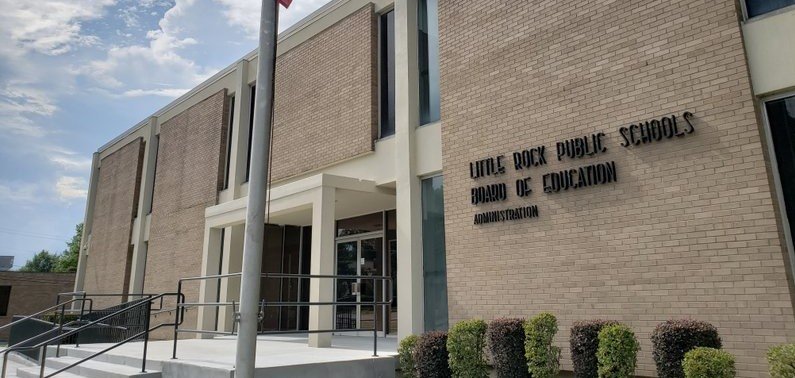The Little Rock School Board voted 9-0 Thursday to ratify an exit plan meant to eventually extract the 21,000-student district from the intensive support category of the state's school accountability system.
Deputy Superintendent Jeremy Owoh recommended that the newly elected board approve the plan, which was developed earlier by the Arkansas Division of Elementary and Secondary Education in consultation with district leaders.
"This ratification ... is a major step in making sure that all parties are together, moving forward, when it comes to major financial decisions and program implementation," Owoh told the board in advance of the vote.
The vote is one of the first actions of the nine-member board that was elected late last year to govern a district that had been operating under state control with no locally elected board for nearly six years.
The state Education Board voted in 2019 to return the district to a local school board but with restrictions until the district is removed from the "Level 5 -- Intensive Support" category of the state accountability system.
Until the district is removed from Level 5, the new board cannot file lawsuits, recognize a union as a bargaining agent for employees, alter the structure of the district's personnel policies committees or change superintendents without approval from the Arkansas Board of Education.
The exit plan was previously ratified by the district's now-defunct state-appointed Community Advisory Board, which acted as an advisory board to Education Secretary Johnny Key, who served in lieu of a school board in the district.
Terms of the exit plan call for the district to use the professional learning communities model and Robert Marzono's High Reliability Schools framework for organizing the work of a school to accomplish greater student achievement.
It also calls for:
• Teacher and administrator evaluation systems that help educators improve instruction.
• Implementation of the district's adopted reading curriculum that relies on science of reading research and includes support for students who show characteristics of dyslexia.
• A three-year budget plan that does not result in district operators dipping into reserve funds to meet routine operating expenses.
• An approved master facilities plan.
Owoh said state education leaders are seeking artifacts and evidence that the exit plan provisions are in place in every school and every classroom. State education officials have conducted beginning-of-the-year and mid-year reviews of the district's efforts, and an end-of-the-year review will be done in the spring.
The current exit plan focuses on districtwide practices and does not rely on improvements in state-issued letter grades to individual schools within the district -- which were requirements in a much earlier plan for the release from state control.
School Board member Jeff Wood said he was grateful that the state had eased its earlier exit requirements but he saw the exit plan as a minimum for the district. He urged that the district focus on improving student achievement.
School Board member Ali Noland asked Superintendent Mike Poore what his concerns were about obtaining release from the intensive support category. Poore said that when the exit criteria were initially developed the district's financial situation was viewed as one of the district's strengths.
"But that was prior to the pandemic and the loss of students, and the uncertainty of where tax collections [to finance the schools] might be," he said.
The district's kindergarten-through-fifth-grade school enrollment has dropped by 700 pupils this school year, and the prekindergarten enrollment is down by 800 children.
"It's very hard to start to imagine what a budget looks like for the coming years with that many fewer students," Poore said. "The other areas have become strengths because they are much more in our control and in our grasp," he said about employee evaluation systems, the reading curriculum and the structured collaboration among groups of educators about their students and instruction.
"We are doing those things with high fidelity, and we are getting high marks from the state," he added.
Thursday's meeting included a lengthy presentation from Chief Financial Officer Kelsey Bailey and district financial adviser Jack Truemper of Stephens Inc., on the district's finances, including the $3.945 billion in assessed value of property within the district's boundaries. That assessed value has grown by 2.72% over five years, to the point that one tax mill generates nearly $3.5 million in revenue for the school system, Truemper said.
The district's tax rate is 46.4 mills, 34 mills of which are earmarked for operating costs such as employees' salaries, utilities and technology. The remaining 12.4 mills are earmarked for paying off bond debt for construction projects. The district's current overall debt is $225.2 million, which is a "low" 5.71% of the assessed value as compared with percentage of debt statewide, Truemper said.
Poore said he and his staff are likely to propose at the board's February meeting a plan for asking voters to approve extending the school district's debt for a longer time as a way to raise new money for construction projects.
The district's top construction priority is replacing Cloverdale Middle School with a new school at a cost of as much as $60 million on the property where the now vacant McClellan High campus is located. That replacement is a commitment that the district made in a settlement to a federal lawsuit.
Little Rock School District voters in November rejected a proposed 18-year extension of 12.4 debt service property tax mills. The proposed extension would not have raised annual taxes but would have required the taxes to be paid for more years.
A similar tax extension plan was defeated by voters in a special election in May 2017.
Both times opponents to the tax plans cited the fact that the district was operating under state control.
